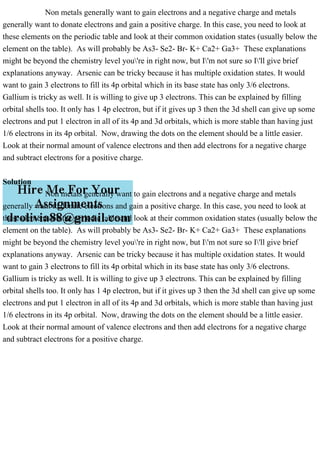Non metals generally want to gain electrons and a.pdf
Non metals generally want to gain electrons and a negative charge and metals generally want to donate electrons and gain a positive charge. In this case, you need to look at these elements on the periodic table and look at their common oxidation states (usually below the element on the table). As will probably be As3- Se2- Br- K+ Ca2+ Ga3+ These explanations might be beyond the chemistry level you\'re in right now, but I\'m not sure so I\'ll give brief explanations anyway. Arsenic can be tricky because it has multiple oxidation states. It would want to gain 3 electrons to fill its 4p orbital which in its base state has only 3/6 electrons. Gallium is tricky as well. It is willing to give up 3 electrons. This can be explained by filling orbital shells too. It only has 1 4p electron, but if it gives up 3 then the 3d shell can give up some electrons and put 1 electron in all of its 4p and 3d orbitals, which is more stable than having just 1/6 electrons in its 4p orbital. Now, drawing the dots on the element should be a little easier. Look at their normal amount of valence electrons and then add electrons for a negative charge and subtract electrons for a positive charge. Solution Non metals generally want to gain electrons and a negative charge and metals generally want to donate electrons and gain a positive charge. In this case, you need to look at these elements on the periodic table and look at their common oxidation states (usually below the element on the table). As will probably be As3- Se2- Br- K+ Ca2+ Ga3+ These explanations might be beyond the chemistry level you\'re in right now, but I\'m not sure so I\'ll give brief explanations anyway. Arsenic can be tricky because it has multiple oxidation states. It would want to gain 3 electrons to fill its 4p orbital which in its base state has only 3/6 electrons. Gallium is tricky as well. It is willing to give up 3 electrons. This can be explained by filling orbital shells too. It only has 1 4p electron, but if it gives up 3 then the 3d shell can give up some electrons and put 1 electron in all of its 4p and 3d orbitals, which is more stable than having just 1/6 electrons in its 4p orbital. Now, drawing the dots on the element should be a little easier. Look at their normal amount of valence electrons and then add electrons for a negative charge and subtract electrons for a positive charge..

Recommended
Recommended
More Related Content
Similar to Non metals generally want to gain electrons and a.pdf
Similar to Non metals generally want to gain electrons and a.pdf (20)
More from ANGELMARKETINGJAIPUR
More from ANGELMARKETINGJAIPUR (20)
Recently uploaded
Recently uploaded (20)
Non metals generally want to gain electrons and a.pdf
- 1. Non metals generally want to gain electrons and a negative charge and metals generally want to donate electrons and gain a positive charge. In this case, you need to look at these elements on the periodic table and look at their common oxidation states (usually below the element on the table). As will probably be As3- Se2- Br- K+ Ca2+ Ga3+ These explanations might be beyond the chemistry level you're in right now, but I'm not sure so I'll give brief explanations anyway. Arsenic can be tricky because it has multiple oxidation states. It would want to gain 3 electrons to fill its 4p orbital which in its base state has only 3/6 electrons. Gallium is tricky as well. It is willing to give up 3 electrons. This can be explained by filling orbital shells too. It only has 1 4p electron, but if it gives up 3 then the 3d shell can give up some electrons and put 1 electron in all of its 4p and 3d orbitals, which is more stable than having just 1/6 electrons in its 4p orbital. Now, drawing the dots on the element should be a little easier. Look at their normal amount of valence electrons and then add electrons for a negative charge and subtract electrons for a positive charge. Solution Non metals generally want to gain electrons and a negative charge and metals generally want to donate electrons and gain a positive charge. In this case, you need to look at these elements on the periodic table and look at their common oxidation states (usually below the element on the table). As will probably be As3- Se2- Br- K+ Ca2+ Ga3+ These explanations might be beyond the chemistry level you're in right now, but I'm not sure so I'll give brief explanations anyway. Arsenic can be tricky because it has multiple oxidation states. It would want to gain 3 electrons to fill its 4p orbital which in its base state has only 3/6 electrons. Gallium is tricky as well. It is willing to give up 3 electrons. This can be explained by filling orbital shells too. It only has 1 4p electron, but if it gives up 3 then the 3d shell can give up some electrons and put 1 electron in all of its 4p and 3d orbitals, which is more stable than having just 1/6 electrons in its 4p orbital. Now, drawing the dots on the element should be a little easier. Look at their normal amount of valence electrons and then add electrons for a negative charge and subtract electrons for a positive charge.